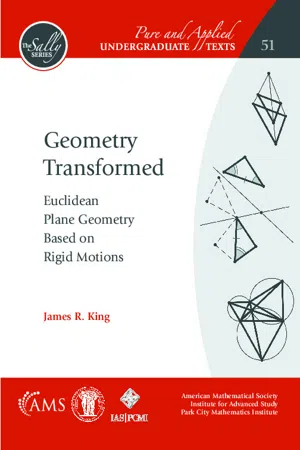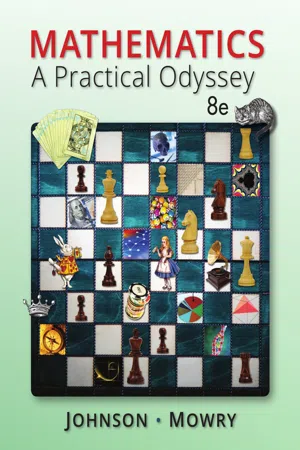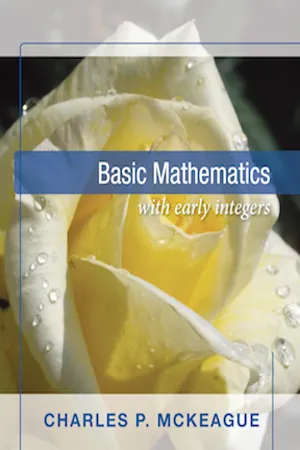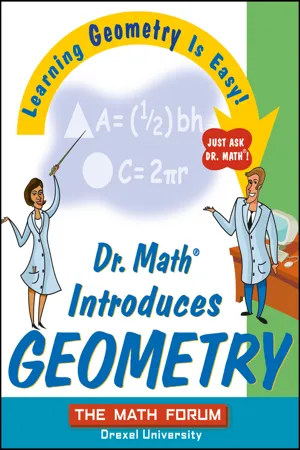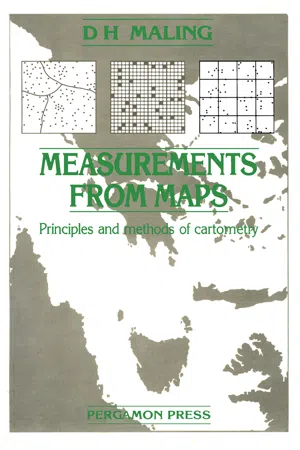Mathematics
Area and Perimeter of Quadrilaterals
The area of a quadrilateral is the measure of the space inside the shape, calculated using various formulas depending on the type of quadrilateral. The perimeter of a quadrilateral is the total length of its sides. For example, the area of a rectangle can be found using the formula length × width, while the perimeter is calculated by adding all four sides together.
Written by Perlego with AI-assistance
Related key terms
1 of 5
12 Key excerpts on "Area and Perimeter of Quadrilaterals"
- eBook - PDF
- (Author)
- 2015(Publication Date)
- For Dummies(Publisher)
In the previous section, the perimeter formulas deal with linear measure. Linear measure is just one dimension. It’s from one place to another — there’s no breadth to it. You measure it with a ruler or tape measure in one direction. Square measurements are used to measure area. Area takes two measures — one along a side and a second perpendicular (90 degrees) to that side. Laying out rectangles and squares Rectangles and squares have basically the same area formulas because they both have square corners and the equal lengths on opposite sides. The general procedure here is just to multiply the measure of the length times the measure of the width. The product of two sides that are next to one another is the area. Finding the area of a rectangle or square Most rooms in homes, schools and offices are rectangular in shape. Desks and tables and rugs are usually rectangular, also. This makes it easy to fit furniture and other objects in the room. The area of a rectangle is its length times its width, and the area of a square is the square of the measure of any side: Rectangle: A = l × w Square: A = s 2 Say a garden 35 metres long by 15 metres wide needs some fertiliser. If a bag of fertiliser covers 6 square metres, how much fertiliser do you need? First determine how many square metres the garden is. area of garden = l × w = 35 × 15 = 525 square metres Divide the 525 square metres by 6 square metres: 525 ÷ 6 = 87.5 square metres You can buy 88 bags and have some left over, or buy 87 bags and skimp a little in some places. 322 Part IV: Applying Algebra and Understanding Geometry Tuning in triangles Finding the area of a triangle can be a bit of a challenge. Basically, a triangle’s area is half that of an imaginary rectangle that the triangle fits into. However, it isn’t always easy or necessary to find the length and width of this hypothetical rectangle — you just need a measurement or two from the triangle. - eBook - PDF
Geometry Transformed
Euclidean Plane Geometry Based on Rigid Motions
- James R. King(Author)
- 2021(Publication Date)
- American Mathematical Society(Publisher)
Chapter 9 Area and Its Applications Areas of Triangles and Parallelograms Area, a familiar and useful topic in the real world, is not only an interesting topic in geometry; it also provides an additional tool for understanding geometrical relation-ships. While it is simple in some respects, it is not so simple in others. The simple part includes the familiar formulas for areas of rectangles, triangles, parallelograms, and other basic polygons. The not-so-simple part is expressing a general definition of area and then proving it agrees with the simple formulas but also applies to shapes such as circles and other nonpolygonal shapes. To derive an area formula for circles, limits are involved. This is as far as we will be going in this book. 1 Area should have these properties: • Congruent figures have the same area. • For a square ? of side length 1, the area 𝒜(?) = 1 . • If the set ? 1 contains ? 2 , then 𝒜(? 1 ) ≥ 𝒜(? 2 ) . • If a set ? is the union of a finite number ? 1 , ? 2 , ... , ? 𝑘 of convex polygons and their interiors such that the polygon interiors do not intersect, then 𝒜(?) = 𝒜(? 1 ) + 𝒜(? 2 ) + ⋯ + 𝒜(? 𝑘 ). Squares and the Definition of Area. All our work with area will rely on the areas of squares. Consider how only one definition makes sense. A square of integer side 𝑚 can be divided into 𝑚 2 unit squares of side 1, so the area should be 𝑚 2 . For example, the square on the left of Figure 1 is 9, assuming the small squares have side 1. If the area of a square of side 1 is divided into squares of side length 1/𝑛 , then since there are 𝑛 2 such small squares, the area of the small square should be 1/𝑛 2 . The area of 1 If one investigates really complicated sets in the plane, such as fractals, it turns out that a set may have no area, or it may have more than one value competing to be area. 161 - eBook - ePub
Learning and Teaching Early Math
The Learning Trajectories Approach
- Douglas H. Clements, Julie Sarama(Authors)
- 2020(Publication Date)
- Routledge(Publisher)
11 Geometric Measurement1Area, Volume, and Angle
I had a student who basically understood the difference between area and perimeter. I drew this rectangle on a grid. To figure the area, she counted down like this (Figure 11.1a ), then she counted across like this (Figure 11.1b ). Then she multiplied 3 times 4 and got 12. So, I asked her what the perimeter was. She said it was “the squares around the outside.” She counted like this (Figure 11.1c ). She understood the perimeter, she just counted wrong. She was always off by 4.Do you agree with this teacher? Does the student understand area and perimeter and distinguish between them? What would you have asked the student to find out for sure?Figure 11.1 A student works with a perimeter problemArea Measurement
Area is an amount of two-dimensional surface that is contained within a boundary. Area is complex, and children develop area concepts over time. Sensitivity to area is present in the first year of life, as is sensitivity to number. However, infants’ approximate number sense is more accurate than their corresponding sense of area. So, even infants find area challenging!Area understandings do not develop well in typical U.S. instruction and have not for a long time. Young children show little explicit understanding of measurement. Primary graders, asked how much space a square would cover, used a ruler (once) to measure. Even with manipulatives, many measured a length of a side of a square, then moved the ruler to a parallel position slightly toward the opposite side, and, repeating this process, added the values of the lengths (Lehrer et al., 1998b). Limitations in knowledge are also shown by preservice teachers, as the opening story illustrates.To learn area measurement, children must develop a notion of what area is, as well as the understanding that decomposing and rearranging shapes does not affect their area. Later, children can develop the ability to build an understanding of two-dimensional arrays and then to interpret two lengths as measures of the dimensions of those arrays. Without such understandings and abilities, older students often learn a rule, such as multiplying two lengths, without understanding area concepts. Although area measurement is typically emphasized in the elementary grades, the literature suggests that there are some less formal aspects of area measurement that can be introduced in earlier years. - eBook - PDF
Mathematics
A Practical Odyssey
- David Johnson, , Thomas Mowry, , David Johnson, Thomas Mowry(Authors)
- 2015(Publication Date)
- Cengage Learning EMEA(Publisher)
Copyright 2016 Cengage Learning. All Rights Reserved. May not be copied, scanned, or duplicated, in whole or in part. Due to electronic rights, some third party content may be suppressed from the eBook and/or eChapter(s). Editorial review has deemed that any suppressed content does not materially affect the overall learning experience. Cengage Learning reserves the right to remove additional content at any time if subsequent rights restrictions require it. 8.1 Perimeter and Area 539 n Polygons Two-dimensional figures can be classified by the number of sides they have. A polygon is a many-sided figure. A pentagon is a five-sided figure, a hexagon is a six-sided figure, and an octagon is an eight-sided figure. However, the names of polygons do not necessarily end with -gon . Although a three-sided figure could be called a trigon , we prefer triangle . Likewise, a four-sided figure is referred to as a quadrilateral rather than a quadragon. Our study of polygons focuses on finding the distance around a figure and the amount of space enclosed within the figure. Some of the polygons we will examine are shown in Figure 8.1. The symbol ∟ represents an angle of 90 8 (90 degrees 5 a square corner). rectangle square parallelogram trapezoid right triangle triangle Figure 8.1 Common polygons. Architect Frank Lloyd Wright used simple geometric shapes to design this stained glass window in 1911. Digital Image © The Museum of Modern Art/Licensed by SCALA/Art Resource, NY The perimeter of (or distance around) a two-dimensional figure is the sum of the lengths of its sides. As shown in Figure 8.2, the perimeter of a rect-angular scarf 18 inches wide and 2 feet long is 7 feet. (We must first convert 18 inches into 1.5 feet.) perimeter 5 distance around 5 1.5 ft 1 2 ft 1 1.5 ft 1 2 ft 5 7 ft 2 ft 2 ft 1.5 ft 1.5 ft Figure 8.2 Finding the perimeter of a rectangular scarf. - eBook - PDF
- Charles P. McKeague(Author)
- 2011(Publication Date)
- XYZ Textbooks(Publisher)
Geometry Suppose a rectangle has a perimeter of 12 inches. If the length and the width are whole numbers, give all the possible values for the width. As- sume the width is shorter side and the length is the longer side. 32. Geometry Suppose a rectangle has a perimeter of 10 inches. If the length and the width are whole numbers, give all the possible values for the width. As- sume the width is the shorter side and the length is the longer side. 33. Geometry If a rectangle has a perimeter of 20 feet, is it possible for the rect- angle to be a square? Explain your answer. 34. Geometry If a rectangle has a perimeter of 10 feet, is it possible for the rect- angle to be a square? Explain your answer. 35. Geometry A rectangle has a perimeter of 9.5 inches. If the length is 2.75 inches, find the width. 36. Geometry A rectangle has a perimeter of 11 inches. If the width is 2.5 inches, find the length. Getting Ready for the Next Section Simplify each expression. Round your answers to the nearest hundredth. 37. 1 } 2 ? 6 ? 3 39. 1 } 2 1 2 5 } 8 21 1 1 } 4 2 41. 3.14(14.5) 2 43. 144 2 36(3.14) 38. 1 } 2 ? 4 ? 2 40. 1 } 2 (6.6)(3.3) 42. 3.14(5) 2 44. 100 2 25(3.14) 8.2 Area 449 8.2 Recall that the area of a flat object is a measure of the amount of surface the ob- ject has. The area of the rectangle below is 8 square centimeters, because it takes 8 square centimeters to cover it. Area As we have noted previously, the area of this rectangle can also be found by mul- tiplying the length and the width. Area 5 (length) ? (width) 5 (4 centimeters) ? (2 centimeters) 5 (4 ? 2) ? (centimeters ? centimeters) 5 8 square centimeters From this example, and others, we conclude that the area of any rectangle is the product of the length and width. Here are the most common geometric figures along with the formula for the area of each one. The only formulas that are new to us are the ones that accom- pany the parallelogram and the circle. - eBook - PDF
- Kip Téllez, Judit N. Moschkovich, Marta Civil(Authors)
- 2016(Publication Date)
- Information Age Publishing(Publisher)
The teachers realized that by removing a corner of a rectangle, they had changed the area without changing the perimeter. 206 C. O. ANHALT and M. ONDRUS As it turns out, there is a geometric shortcut for finding the perimeter of the shape (on the left) in Figure 9.7, and this method is illustrated in Figure 9.8. (3a + 2b) + a – 2b + 3b + 3b = 4a + 6b (3a + 2b) + a + 2b + 2b = 4a + 6b Figure 9.8 A geometric approach to finding the perimeter. In planning for the lesson, we anticipated that teachers would discover this geometric method, but in fact, the teachers did not find it. One impor- tant goal was for the teachers to understand both algebraically and geo- metrically that area and perimeter may have very little to do with one an- other, and it was evident from the class discussion of these activities that this goal was met. Another critical goal was for teachers to learn to experiment mathematically and subsequently make and test mathematical conjectures. We believed that this goal was best achieved by encouraging the teachers to continue to search for a geometric method for finding the perimeter of a shape such as the one shown in Figure 9.8. In recent years, there has been an interest in infusing early-grade curric- ulum with algebraic or prealgebraic thinking (see, for example, Greenes, 2003). The use of algebra blocks to study perimeter may provide a powerful way to teach algebraic thinking in earlier grades. For example, a teacher may arbitrarily designate that the lengths of the sides of the algebra blocks are, say, 2.1 (of some unit) and 7 (of the same unit), as shown in Figure 9.9. The essential point is that 7 is not an integer multiple of 2.1, and thus these lengths are consistent with the manner in which the blocks are designed. 7 7 2.1 7 2.1 2.1 Figure 9.9 Algebra blocks with arbitrary concrete side-lengths. - eBook - PDF
Mathematical Practices, Mathematics for Teachers
Activities, Models, and Real-Life Examples
- Ron Larson, Robyn Silbey(Authors)
- 2014(Publication Date)
- Cengage Learning EMEA(Publisher)
Find the perimeter and area of the rectangle by using formulas. Count the numbers of linear units and square units to check your answers. 8. Perimeter and Area of a Rectangle The distance between 2 horizontal dots or 2 vertical dots is 1 unit. Find the perimeter and area of the rectangle by using formulas. Count the numbers of linear units and square units to check your answers. 9. Perimeter and Area of a Rectangle Find the perimeter and area of the rectangle. 80 ft 25 ft 11.2 Exercises Free step-by-step solutions to odd-numbered exercises at MathematicalPractices.com. Free step-by-step solutions to odd-numbered exercises at MathematicalPractices.com. Copyright 2014 Cengage Learning. All Rights Reserved. May not be copied, scanned, or duplicated, in whole or in part. Due to electronic rights, some third party content may be suppressed from the eBook and/or eChapter(s). Editorial review has deemed that any suppressed content does not materially affect the overall learning experience. Cengage Learning reserves the right to remove additional content at any time if subsequent rights restrictions require it. Section 11.2 Perimeters and Areas of Polygons 429 10. Perimeter and Area of a Rectangle Find the perimeter and area of the rectangle. 3.5 m 1.2 m 11. Area of a Parallelogram The distance between 2 horizontal dots or 2 vertical dots is 1 unit. Find the area of the parallelogram by using a formula, and then by counting the number of square units. Explain how you counted the number of square units. 12. Area of a Trapezoid The distance between 2 horizontal dots or 2 vertical dots is 1 unit. Find the area of the trapezoid by using a formula, and then by counting the number of square units. Explain how you counted the number of square units. 13. Area of a Parallelogram Find the area of the parallelogram. 8 cm 10 cm 9 cm 14. Area of a Parallelogram Find the area of the parallelogram. 21 ft 24 ft 21 ft 15. Area of a Trapezoid Find the area of the trapezoid. - eBook - PDF
Dr. Math Introduces Geometry
Learning Geometry is Easy! Just ask Dr. Math!
- (Author)
- 2004(Publication Date)
- Jossey-Bass(Publisher)
So its length is a + b — 2 . We can also construct perpendicular lines from those midpoints to the bottom to construct small right triangles, as in this figure: If we rotate those right triangles up around the midpoints until they hit the side of the trapezoid, we end up with a rectangle. Areas and Perimeters of Two-Dimensional (2-D) Geometric Figures 83 84 Dr. Math Introduces Geometry R And if you look carefully, you’ll see that the length of the rectangle is a + b — 2 and the height is h, so the area is which is the same as the formula we’ve learned for the area of a trapezoid. —Dr. Math, The Math Forum esources on the Web Learn more about area and perimeter at these sites: Math Forum: An Informal Investigation of Area mathforum.org/workshops/sum98/participants/muenster/ Step-by-step activity exploring the area of an irregular shape. Math Forum: The Area of a Parallelogram mathforum.org/te/exchange/hosted/basden/llgramarea.html Students learn to calculate the area of a parallelogram. Math Forum: What Is Area? mathforum.org/alejandre/frisbie/student.one.inch.tiles.html Collaborative group activity comparing area and perimeter using Hands-On Math software by Ventura Educational Systems, but the ideas could be adapted to use with other software or a Java applet. Shodor Organization: Project Interactivate: Area Explorer shodor.org/interactivate/activities/perm/ Students are shown shapes on a grid after setting the perimeter and are asked to calculate the areas of the shapes. area of rectangle = a b h + ⋅ 2 Shodor Organization: Project Interactivate: Perimeter Explorer shodor.org/interactivate/activities/permarea/ Students are shown shapes on a grid after setting the area and are asked to calculate the perimeters of the shapes. Shodor Organization: Project Interactivate: Shape Explorer shodor.org/interactivate/activities/perimeter/ Students are shown shapes on a grid and are asked to calculate the areas and the perimeters of the shapes. - eBook - PDF
Measurements from Maps
Principles and Methods of Cartometry
- D H Maling(Author)
- 2016(Publication Date)
- Butterworth-Heinemann(Publisher)
The Area of a Rectangle In Fig. 16.1(b) the rectangle ABCD has the sides AB = a and BC = b. Quite simply. A = a-b (16.7) The Area of a Parallelogram In Fig. 16.1(c) the figure has side AB = a and BC = b. Also h is the length of the perpendicular to one pair of the parallel sides. Then A = ah (16.8) Also A = abs'mB (16.9) The Area of a Rhombus The length of each side of the figure is equal to a. In Fig. 16.1(d) the lengths of the diagonals, AC and BD are also known, A = {-(AC-BD)-sin Β (16.10) Also, as a special case of (16.9) A = a 2 s'mB (16.11) The Area of a Trapezoid In Fig. 16.1 (e) the lengths of the pair of parallel sides A Β and CD are known; so, too, is the perpendicular distance, ft, between them. Then A={h(AB + CD) (16.12) 330 Measurements from Maps The Area of Any Quadrilateral The length of the diagonal BD is known; so, too are the length of the two perpendiculars h x and h 2 joining the diagonal BD to A and DC respectively. A = 2 ^BD(h l + h 2 ) (16.13) If the area of the figure is to be determined from measurement on a map or plan, it is usually preferable to employ the formulae which make use of linear measurements only, for these can be measured more accurately than angular measurements. An exception to this rule occurs when special equipment intended to measure angles is used. The Coradi Digimeter Model D M P , to be described later, is a case in point, because this measures polar coordinates. Similarly, if angular measurements have been made in the field, there is little objection to the use of them arid equations such as (16.2)—(16.4) and (16.9) may be employed. DETERMINATION OF THE AREA OF THE FRAMEWORK OF A PARCEL The geometrical method of determining the area of the framework of a parcel comprises subdivision of the parcel into a network of simple geometrical figures, measuring certain elements of these figures, calculating the individual areas of them and finally combining the results. - eBook - PDF
Introductory Mathematics
Concepts with Applications
- Charles P. McKeague(Author)
- 2013(Publication Date)
- XYZ Textbooks(Publisher)
A Perimeter We begin this section by reviewing the definition of a polygon, and the definition of perimeter. The most common polygons are squares, rectangles, and triangles. 11.3 ft 9.8 ft 2.6 ft 4 ft 59 ft 44 ft FIGURE 1 DEFINITION polygon A polygon is a closed geometric figure, with at least three sides, in which each side is a straight line segment. DEFINITION perimeter The perimeter of any polygon is the sum of the lengths of the sides, and it is denoted with the letter P . ©iStockphoto.com/ isitsharp 391 8.1 Perimeter and Circumference To find the perimeter of a polygon we add all the lengths of the sides together. Here are the most common polygons, along with the formula for the perimeter of each. We can justify our formulas as follows. If each side of a square is s units long, then the perimeter is found by adding all four sides together. Perimeter = P = s + s + s + s = 4s Likewise, if a rectangle has a length of l and a width of w, then to find the perimeter we add all four sides together. Perimeter = P = l + l + w + w = 2l + 2w EXAMPLE 1 Find the perimeter of the given rectangle. Solution The rectangle has a width of 5 yards and a length of 8 yards. We can use the formula for P = 2l + 2w to find the perimeter. P = 2(8) + 2(5) = 16 + 10 = 26 yards EXAMPLE 2 Find the perimeter of each of the following stamps. Write your answer as a decimal, rounded to the nearest tenth, if necessary. a. Each side is 35.0 millimeters. b. Base = 2 5 _ 8 inches, Other two sides = 1 7 _ 8 inches c. Length = 1.56 inches, Width = 0.99 inches P = 4s s Square P = 2l + 2w l Rectangle w P = a + b + c b h a c Triangle Practice Problems 1. Find the perimeter. 12 ft 7 ft 8 yd 5 yd 2. Find the perimeter of the stamps in Example 2 if they had the following dimensions. Round to the nearest tenth if necessary. a. Each side is 42 millimeters. b. Base = 3 4 _ 5 inches Other two sides = 1 2 _ 5 inches c. Length = 3.86 inches Width = 1.34 inches Answers 1. 38 ft 2. - eBook - PDF
- John Peterson, Robert Smith(Authors)
- 2019(Publication Date)
- Cengage Learning EMEA(Publisher)
437 Geometric Figures: Areas and Volumes 6 OBJECTIVES After studying this unit you should be able to ● ● Express given customary area measures in larger and smaller units. ● ● Express given metric area measures in larger and smaller units. ● ● Convert between customary area measures and metric area measures. ● ● Compute areas, lengths, and widths of rectangles. ● ● Compute areas, bases, and heights of parallelograms. ● ● Compute areas, both bases, and heights of trapezoids. ● ● Compute areas of more complex figures (composite figures) that consist of two or more common polygons. As previously stated, in machine technology linear or length measure is used more often than area and volume measure. However, the ability to compute areas and volumes is required in determining job-material quantities and costs. Often, before a product is manufactured, part weights are computed. Volumes of simple geometric figures and combinations of figures (composite figures) must be calculated before weights can be determined. Section 6 presents area and volume measure of two-dimensional and three-dimensional geometric figures and practical area and volume applications. Areas of Rectangles, Parallelograms, and Trapezoids UNIT 59 CUSTOMARY AND METRIC UNITS OF SURFACE MEASURE (AREA) A surface is measured by determining the number of surface units contained in it. A surface is two dimensional. It has a length and width, but no thickness. Both length and width must be expressed in the same unit of measure. Area is computed as the SECTION SIX 438 SECTION 6 GEOMETRIC FIGURES: AREAS AND VOLUMES product of two linear measures and is expressed in square units. For example, 2 inches 3 4 inches 5 8 square inches (8 sq in. or 8 in. 2 ). The surface enclosed by a square that is 1 inch on a side is 1 square inch (1 sq in. or 1 in. 2 ). The surface enclosed by a square that is 1 foot on a side is 1 square foot (1 sq ft or 1 ft 2 ). - No longer available |Learn more
- Daniel C. Alexander, Geralyn M. Koeberlein, , , Daniel C. Alexander, Geralyn M. Koeberlein(Authors)
- 2014(Publication Date)
- Cengage Learning EMEA(Publisher)
CHAPTER OUTLINE 4.1 Properties of a Parallelogram 4.2 The Parallelogram and Kite 4.3 The Rectangle, Square, and Rhombus 4.4 The Trapezoid ■ PERSPECTIVE ON HISTORY: Sketch of Thales ■ PERSPECTIVE ON APPLICATIONS: Square Numbers as Sums ■ SUMMARY Chapter 4 © Richard A. Cooke/CORBIS. 169 Quadrilaterals Comforting! Designed by architect Frank Lloyd Wright (1867–1959), this private home is nestled among the trees in the Bear Run Nature Preserve of southwestern Pennsylvania. Known as Fallingwater, this house was constructed in the 1930s. The geometric figure that dominates the homes designed by Wright is the quadrilat-eral. In this chapter, we consider numerous types of quadrilaterals— among them the parallelogram, the rhombus, and the trapezoid. Also, the language and properties for each type of quadrilateral are developed. Each type of quadrilateral has its own properties and applications. Many of these real-world applications can be found in the examples and exercises of Chapter 4. Additional video explanations of concepts, sample problems, and applications are available on DVD. Copyright 2013 Cengage Learning. All Rights Reserved. May not be copied, scanned, or duplicated, in whole or in part. Due to electronic rights, some third party content may be suppressed from the eBook and/or eChapter(s). Editorial review has deemed that any suppressed content does not materially affect the overall learning experience. Cengage Learning reserves the right to remove additional content at any time if subsequent rights restrictions require it. 170 CHAPTER 4 ■ QUADRILATERALS Unless otherwise noted, all content on this page is © Cengage Learning. A quadrilateral is a polygon that has exactly four sides. Unless otherwise stated, the term quadrilateral refers to a plane figure such as ABCD in Figure 4.1(a), in which the line seg-ment sides lie within a single plane.
Index pages curate the most relevant extracts from our library of academic textbooks. They’ve been created using an in-house natural language model (NLM), each adding context and meaning to key research topics.

